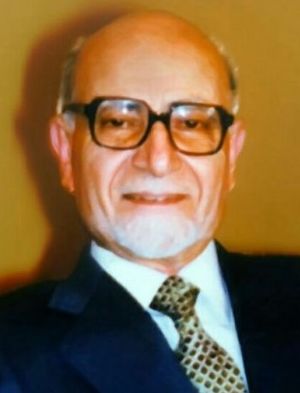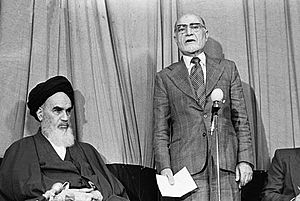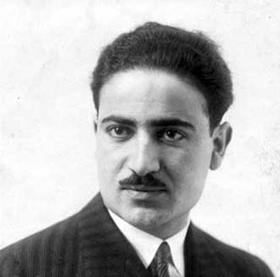Mehdi Bazargan facts for kids
Quick facts for kids
Mehdi Bazargan
|
|
|---|---|

Bazargan in 1979
|
|
| 46th Prime Minister of Iran | |
| In office 4 February 1979 – 6 November 1979 |
|
| Appointed by | Ruhollah Khomeini |
| Preceded by | Shapour Bakhtiar |
| Succeeded by | Mohammad-Ali Rajai (1980) |
| Minister of Foreign Affairs Acting |
|
| In office 1 April 1979 – 12 April 1979 |
|
| Prime Minister | Himself |
| Preceded by | Karim Sanjabi |
| Succeeded by | Ebrahim Yazdi |
| Member of the Parliament of Iran | |
| In office 28 May 1980 – 28 May 1984 |
|
| Constituency | Tehran, Rey and Shemiranat |
| Majority | 1,447,316 (68%) |
| Personal details | |
| Born |
Mehdi Bazargan
1 September 1907 Tehran, Sublime State of Persia |
| Died | 20 January 1995 (aged 87) Zürich, Switzerland |
| Resting place | Qom, Iran |
| Nationality | Iranian |
| Political party |
|
| Other political affiliations |
|
| Spouse | Malak Tabatabayi |
| Children | 5, including Abdolali |
| Alma mater |
|
| Signature |  |
| Military service | |
| Allegiance | Iran |
| Years of service | 1935–1937 |
Mehdi Bazargan (Persian: مهدی بازرگان; 1 September 1907 – 20 January 1995) was an important Iranian thinker and activist. He believed in democracy and worked for it for many years. He became the first prime minister of Iran after the Iranian Revolution in 1979.
He was chosen for this role by Ayatollah Khomeini in February 1979. Bazargan stepped down from his position in November of the same year. This was partly because of the US Embassy takeover. He felt his government could not stop it.
Bazargan also led the first engineering department at the University of Tehran.
Contents
Early Life and Education
Mehdi Bazargan was born in Tehran, Iran, on 1 September 1907. His family was from Azerbaijan. His father, Hajj Abbasqoli Tabrizi, was a successful merchant. He was also a religious activist in the local markets, called bazaar guilds.
Bazargan received a scholarship from the Iranian government to study in France. This was during the time of Reza Shah. He attended Lycée Georges Clemenceau in Nantes. Later, he studied thermodynamics and engineering at the École Centrale des Arts et Manufactures in Paris.
After returning to Iran, Bazargan joined the military. This was a required service called conscription. He served from 1935 to 1937. He helped by translating technical articles from French.
Career and Political Work
After finishing his studies, Bazargan became the head of the first engineering department at Tehran University. This was in the late 1940s. In the 1950s, he worked as a deputy minister. This was under Prime Minister Mohammad Mosaddegh.
Bazargan also became the first Iranian head of the National Iranian Oil Company. This was during Mosaddegh's time as prime minister.
In 1961, Bazargan helped start the Liberation Movement of Iran. This political party had similar goals to Mossadegh's National Front. Even though he accepted the Shah, Mohammad Reza Pahlavi, as the leader of the country, Bazargan was put in jail many times for his political views. He greatly admired Mahatma Gandhi. He wrote about Gandhi's ideas and the Indian independence movement as a good example for Iranians.
The Iranian Revolution
On 4 February 1979, Ayatollah Khomeini chose Bazargan to be the prime minister of Iran. Bazargan was seen as a leader who believed in democracy and freedom. However, he often disagreed with the more radical religious leaders as the revolution continued. This included Khomeini himself.
Bazargan was a religious person. But he first wanted the country to be called an Islamic Democratic Republic, not just an Islamic Republic. He also supported an early version of the country's constitution. This version was not based on religious rule. He was against the Assembly of Experts for Constitution and the constitution they wrote. This constitution was later adopted as Iran's official law.
In March 1979, Bazargan felt his government did not have enough power. He offered to resign to Ayatollah Khomeini. Khomeini did not accept his resignation. In April 1979, Bazargan and his cabinet members survived an attempt to harm them.
Bazargan and his cabinet finally resigned on 4 November 1979. This happened after the US Embassy in Tehran was taken over. His resignation showed his disagreement with the hostage-taking. It also showed that his government could not free the hostages. It became clear that his hopes for a democratic Iran and good relations with Western countries would not happen.

Bazargan stayed involved in Iranian politics. He became a member of the first Parliament (called Majles). He spoke out against Iran's cultural revolution. He continued to support civil rule and democracy. In November 1982, he wrote an open letter to the speaker of parliament, Akbar Hashemi Rafsanjani. In this letter, he shared his disappointment with the direction the Islamic Revolution was taking.

His time as a member of parliament ended in 1984. During this time, he was a lawmaker for the Iran Freedom Movement. He had founded this movement in 1961. It was later ended in 1990. In 1985, the Council of Guardians did not allow Bazargan to run for president.
His Ideas
Bazargan is respected among modern Muslim thinkers. He is known for his ideas about liberal-democratic Islam. He believed that a country should have a constitution and democratic rules. After the revolution, Bazargan led a group that disagreed with the Revolutionary Council. This council was controlled by the Islamic Republican Party and leaders like Ayatollah Mohammad Hossein Beheshti.
He was against the continuation of the Iran–Iraq War. He also did not want religious leaders to be involved in every part of politics, economy, and society. Because of his views, he faced difficulties from activists and young revolutionaries in Iran.
Attacks He Faced
During the time of the Shah, known as the Pahlavi era, Bazargan's house in Tehran was bombed. This happened on 8 April 1978. A group called the "underground committee for revenge" said they were responsible. This group was thought to be supported by the state.
Ideas on Society and Science
Bazargan also explored ideas about how human society works, linking them to science. He wrote about "human thermodynamics." In his 1956 book, Love and Worship: Human Thermodynamics, he suggested that religion and worship might be connected to evolution. He believed that the true rules of society could be understood through the laws of thermodynamics, which are scientific principles about energy.
Death
Bazargan died from a heart attack on 20 January 1995 in Switzerland. He collapsed at the airport and died at a hospital in Zürich. He was traveling to the United States for heart surgery.
Personal Life
Bazargan married Malak Tabatabai in 1939. They had five children together: two sons and three daughters.
See also
 In Spanish: Mehdí Bazargán para niños
In Spanish: Mehdí Bazargán para niños
- Intellectual movements in Iran
- Iranian Committee for the Defense of Freedom and Human Rights
- Religious-Nationalists


